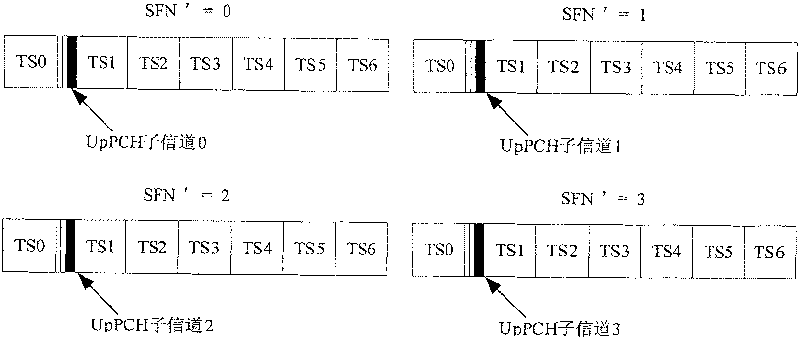Method for identifying different service random access in time-division synchronous CDMA system
A technology of random access and code division multiple access, applied in the field of wireless communication, can solve the problem of different processing
- Summary
- Abstract
- Description
- Claims
- Application Information
AI Technical Summary
Problems solved by technology
Method used
Image
Examples
Embodiment Construction
[0056] The following uses HSUPA access as an example for description.
[0057] Step 1: The network side divides the UpPCH sub-channels in the cell for accessing different services; when configuring the random access resources of the Node B, the relationship between the PRACH and the FPACH is clarified, and it is related to the system information SIB5 / SIB6 The configuration of the random access resources in the network is consistent; the UpPCH sub-channels used for different service accesses are specified during the process of cell establishment and cell reconfiguration for the Node B.
[0058] The number of sub-channels divided by the cell is configured by the high-level network, which can be 1, 2, 4, or 8. When the network side determines the number of sub-channels, it should depend on the business model in the current network. When the number of users is large, the divided The number of sub-channels can be larger, which can avoid conflicts to a certain extent. In the presen...
PUM
 Login to View More
Login to View More Abstract
Description
Claims
Application Information
 Login to View More
Login to View More - R&D
- Intellectual Property
- Life Sciences
- Materials
- Tech Scout
- Unparalleled Data Quality
- Higher Quality Content
- 60% Fewer Hallucinations
Browse by: Latest US Patents, China's latest patents, Technical Efficacy Thesaurus, Application Domain, Technology Topic, Popular Technical Reports.
© 2025 PatSnap. All rights reserved.Legal|Privacy policy|Modern Slavery Act Transparency Statement|Sitemap|About US| Contact US: help@patsnap.com



